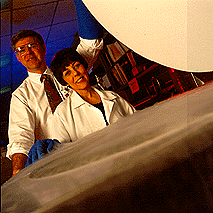 The University of Chicago Magazine June 1996
The University of Chicago Magazine June 1996
 Now open: Stephen Smith and Nina Gallo are stocking their chilly vault with precious blood.
Now open: Stephen Smith and Nina Gallo are stocking their chilly vault with precious blood.Only monthly blood transfusions were keeping 4-year-old Emily Rudlaff alive when her doctors saw another option. A bone-marrow transplant, they knew, should correct the congenital defect that prevented Emily's own marrow from producing red blood cells. But family members didn't match her tissue type, and her partial success with other therapies made her ineligible to receive an unrelated donor's marrow.
Emily's mother, however, was pregnant with another child, and a new technique-transplanting the usually discarded blood from a baby's umbilical cord and placenta-offered an alternative to a bone-marrow transplant. When Emily's sister Natalie was born, the cord blood was removed by syringe and frozen in liquid nitrogen. The sisters' tissue types matched perfectly, so, in February 1995 at the U of C's Wyler Children's Hospital, the transplant went ahead. Emily Rudlaff hasn't needed a blood transfusion since.
The pediatric hematologist-oncologist who performed the transplant, Stephen D. Smith, wants more of his patients to have Emily's chance. About 25 percent of all marrow-transplant candidates, he says-often children with immune disorders or leukemia, or chemotherapy patients with other cancers-die while waiting for a match. Others, like Emily, could benefit from transplants but aren't eligible. And the uncomfortable, $20,000 collection procedure deters potential marrow donors.
The solution, says Smith, a leukemia specialist, is large-scale storage of umbilical-cord blood. Such blood is plentiful, easier and much cheaper to collect (about $1,000 per cord), and an apparently good substitute for marrow in many circumstances.
Other experts generally agree. Last year, the NIH chose sites for four cord-blood donor banks to collect some 20,000 samples. But Smith's laboratory, along with labs at about two dozen other institutions, wasn't a finalist. Undaunted, he's decided to forge ahead with his plans for the U of C-based Midwest Regional Placental Blood Bank. He's even turned rejection into an advantage: His privately funded bank will select more urgently needed types of blood samples, a choosiness that NIH doesn't allow. One focus will be on African-American donors, whose tissue types are poorly represented in the national database of marrow donors.
That cord-blood banking has begun even while the transplants remain experimental illustrates the high hopes of its proponents. Like bone marrow, cord blood is prized for its stem cells, which produce red and white blood cells and platelets, and regenerate themselves throughout their host's lifetime. Cord blood, however, is roughly tenfold richer in stem cells; the 5 ounces typically collected at delivery is enough to replace a child's marrow. Research also suggests that stem cells from cords are less likely to provoke life-threatening tissue rejection. "I've been around enough to see things come and go," says Smith, a boyish 50-year-old, "and I don't see the tragic flaw in this."
Still, doctors have performed only about 200 cord-blood transplants since 1988, and questions both medical and ethical remain. How should the blood be harvested and frozen? How close a match must the donor's tissue be? And what parental consent is needed before a baby's cord blood can be collected and screened for disease?
In his Wyler laboratory, a few yards from the chest-high, stainless-steel freezer that stores his bank's first dozen blood samples, Smith says that many answers should come from the NIH donor banks and forthcoming FDA regulations. Answers will come, too, from smaller banks like Smith's. One unresolved issue, for instance, is the feasibility of cord-blood transplants into adults. Along with his focus on African-American donors, Smith will seek donations from mothers with larger placentas-predicted by factors like maternal weight and fetal size-which should yield the larger blood volumes needed to treat adults.
Over the past two years, Smith and Burton Appel, a fellow in pediatric hematology-oncology, developed the Chicago project's blood-collection procedure. This spring, the bank "opened for business" with a goal to gather donations from 10 percent of the 3,000 mothers who deliver each year at the U of C's Chicago Lying-In Hospital-and from selected deliveries elsewhere-toward a long-term total of several thousand blood samples. While Appel leaves Chicago this summer, the bank now has its first full-time staff member: Registered nurse Nina Gallo will perform collections and help spread the word among obstetricians and expectant mothers.
Yet the fledgling bank faces a financial hurdle. Start-up funding is in place-from the United Blood Services, the Bear Necessities and Ronald McDonald Children's Charities foundations, and the Wyler-based PALS organization for parents of leukemic children. An Allstate employee group even held a recent 10K benefit run. But to keep collecting the $1,000 samples, the bank must charge for "withdrawals." They'll be available to matching recipients worldwide, but Smith estimates only 1 to 5 percent of samples will find hosts. To break even, the bank would need to charge each patient $20,000 to $100,000.
Prohibitively high fees could be offset, says Smith, by adding a "sibling bank"-and there lies an ethical quandary. Like a handful of new, for-profit cord banks, such as ViaCord, a sibling bank charges premium rates to set aside a baby's cord blood for the family's personal use, "just in case."
Some doctors have criticized for-profit and sibling banks as exploiting parents' fears. Smith won't condemn such banks, but he won't run one, either. Earmarking donations, he thinks, removes a still-experimental resource from the public good without clear benefit to anyone. "ViaCord says there's a small chance of its use-and I say no chance," he argues. "Where's the proven medical value to [indefinitely] freezing cord blood? What life has that saved?"
Smith is resigned, then, that fund-raising will be an ongoing need, admitting, "We don't know how we're going to survive." With his credo of nonprofit blood banking, one can imagine the principled pediatrician as Jimmy Stewart in It's a Wonderful Life, explaining to worried customers of the scrappy Bank & Loan that their deposits aren't just idling away, ready for immediate withdrawal-their dollars are off in the community, building homes and businesses. Smith, similarly, foresees a bank where cord blood circulates freely among the needy-and even, on occasion, returns to its depositor: If stem cells transplant successfully, he notes, a donor who later falls ill might get them back, providing the recipient could donate bone marrow.
That may be many years and dollars away, but Stephen Smith is an optimist. "It's a heroic business," he says of his branch of medicine. "We dream a lot."--A.C.